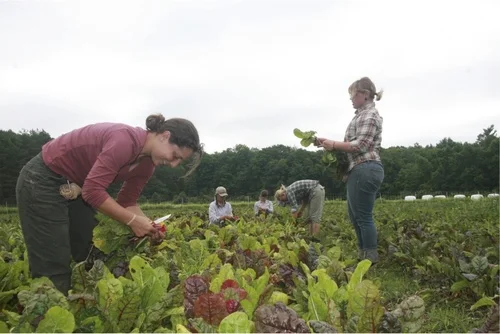“Humanity today is like a waking dreamer, caught between the fantasies of sleep and the chaos of the real world. The mind seeks but cannot find the precise place and hour. We have created a Star Wars civilization, with Stone Age emotions, medieval institutions, and god-like technology. We thrash about. We are terribly confused by the mere fact of our existence, and a danger to ourselves and to the rest of life.”
– Edward O. Wilson, 2012
The 2016 Biodynamic Winter Intensive
The 2016 “Biodynamic Winter Intensive” brought 45 participants (young farmers, food activists, food distributors, landowners and other stakeholders of the agriculture-food system) from North America, Canada and the UK to Hawthorne Valley to explore how agricultural practice can become more mindful of the beautifully coordinated larger rhythms of our celestial universe – its effects on the life of plants and soils, and its earthly reflection through humans caring about food and agriculture.
Uncovering a New Narrative for Agriculture: Wendell Berry and Rudolf Steiner
The basis of this article is a workshop that the authors offered at the 2014 National Biodynamic Conference, which took place in Louisville, Kentucky. The workshop was titled “The Resettling of America”. It seemed appropriate to focus on the work of Wendell Berry, whose farm is located less than 50 miles from Louisville, and whose seminal work carried the prophetic title “The Unsettling of America”. The article follows the workshop in that it compares and contrasts Rudolf Steiner and Wendell Berry who through their writings and practice have presciently postulated a similar viewpoint decades ago. Steiner and Berry’s views foresaw many of today’s individual, socio-cultural, and ecological ills particularly in their relationship to agriculture.
Growing the Next Generation of Farmers in the Hudson Valley
“The dirty secret of the food movement is that the much-celebrated small-scale farmer isn’t making a living. After the tools are put away, we head out to second and third jobs to keep our farms afloat. Ninety-one percent of all farm households rely on multiple sources of income... health care, paying for our kids’ college, preparing for retirement? Not happening...” (Sunday Review, NY Times: “Don’t Let Your Children Grow Up to Be Farmers”)
Agriculture 3.0
Quite some time has passed, about 15 months to be exact, since the scenario of “Agri-culture 3.0” first presented itself to me. It was then—and still is now—an on-going attempt at imagining and formulating a new narrative for agriculture. I deem such a narrative absolutely necessary in order to transform our practice and approach to agriculture in a way that it can be ready to meet the demands and the reality of the emerging future.
Impressions and Reflections of an Amazing Trip to New Zealand
Much gratitude and many thanks for the warm welcome and the amazing and generous hospitality we experienced everywhere Rachel and I went. A resounding thanks to all of you that made this trip possible! So many memories and reflections still reverberate, it will take some time to fully “digest” and internalize them. But let me offer a few thoughts that keep coming up now that we have returned to Hawthorne Valley Farm.
Mindful Agriculture
Why “Mindful Agriculture”? Do we really need another designation for agriculture, you might ask yourself? That is a fair question to arise after encountering the website of this new initiative at Hawthorne Valley Farm. Especially after you see we already have a confusing plethora of descriptive adjectives to distinguish various forms of farming and agriculture.
The Haber-Bosch Process
Michael Pollan in his seminal book on the current food and agriculture system in the United States, The Omnivore’s Dilemma, paraphrases Vaclav Smil in describing the roles of nitrogen and carbon in the natural world. He states, “nitrogen is supplying life’s quality, while carbon provides the quantity” (Pollan, 2006).











